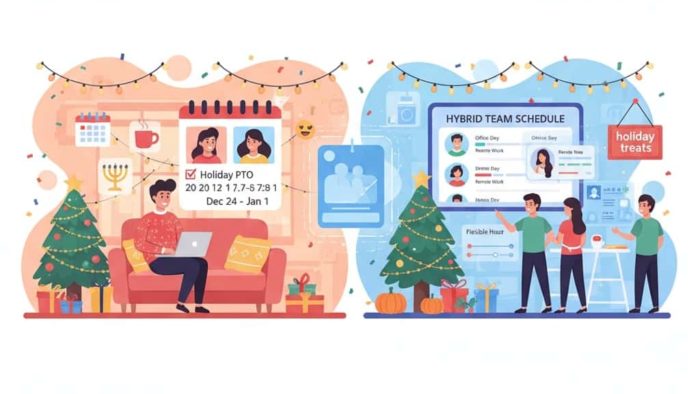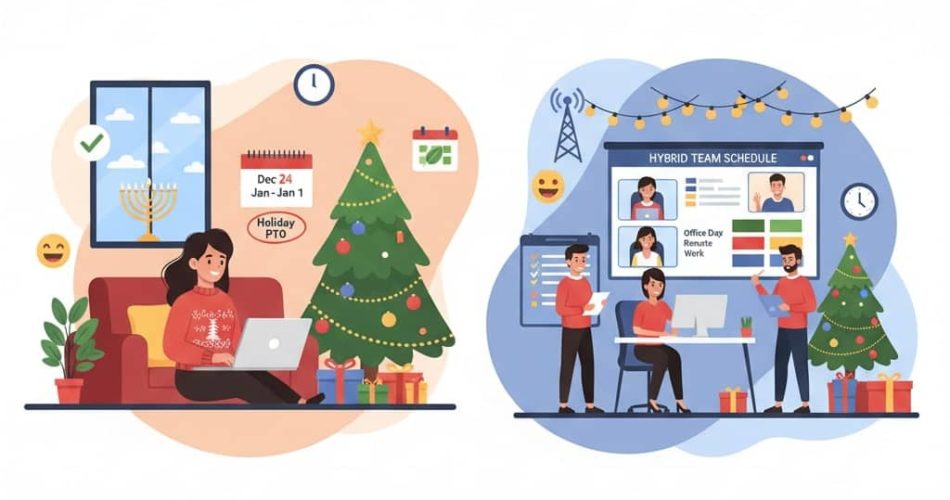As the festive lights start to twinkle, so do the challenges of managing hybrid teams during the holidays. Balancing workloads, time-off requests, and employee engagement becomes a juggling act for HR leaders and managers. The excitement of celebrations often collides with year-end deadlines, leaving teams stretched between spreadsheets and social gatherings. For organizations embracing hybrid work management, this period demands thoughtful planning and clear communication. Whether it’s coordinating remote team collaboration across time zones or ensuring no one feels left out of the holiday spirit, success lies in structure and empathy.
Plan Ahead for the Holiday Rush
The key to managing hybrid teams during the holidays starts long before the celebrations begin. HR leaders and managers should create a clear roadmap that balances business goals with personal time-off requests. Early planning helps prevent last-minute scheduling conflicts and ensures that both in-office and remote employees can enjoy the season without stress.
Begin by setting expectations around project timelines and availability. Encourage team members to submit their holiday leave plans well in advance, giving you time to spot gaps in coverage. Use collaborative tools like shared calendars or digital planners to visualize workloads across departments. Integrating solutions such as AttendanceBot can simplify holiday leave management, making it easier to track who’s in, who’s off, and how the team’s schedule will flow through the festive weeks.
By planning early and communicating openly, organizations can maintain holiday season productivity while giving employees the flexibility they deserve. It’s about finding the right rhythm—where work commitments and celebrations coexist without overwhelming anyone.

How To Manage Hybrid Teams During the Festive and Holiday Season
Successful hybrid work management during holidays requires more than scheduling—it’s about fostering connection, fairness, and balance. The festive season often brings excitement but can also trigger burnout or disengagement if not managed thoughtfully. Here’s how HR leaders and team managers can keep their hybrid teams aligned, productive, and motivated throughout the holiday rush.
1. Set Clear Expectations Early
In a hybrid setup, assumptions can lead to miscommunication—especially during busy periods. Leaders should begin by outlining expectations for availability, deadlines, and meeting schedules well before the holiday season begins. Make sure employees know what’s expected of them, whether they’re working from the office or remotely.
Transparent communication also helps manage workloads fairly. Use shared project trackers and digital tools like AttendanceBot to coordinate holiday leave management and ensure no critical tasks fall through the cracks. By aligning on goals early, you create a sense of structure that reduces last-minute stress and maintains holiday season productivity.
2. Foster Inclusivity and Connection
The festive period can feel isolating for remote employees who miss out on in-office celebrations. To promote inclusivity, organize hybrid-friendly events—like virtual gift exchanges, trivia games, or online appreciation sessions. Encourage managers to personally check in with remote team members, ensuring everyone feels valued and included in the celebrations.
Creating shared experiences strengthens employee engagement during holidays and helps maintain morale across locations. Consider sending care packages or holiday cards to remote employees, symbolizing that distance doesn’t mean disconnection.
3. Balance Flexibility With Accountability
One of the biggest advantages of hybrid work management is flexibility—but it must be balanced with accountability. Offer employees the freedom to adjust their work hours during the festive season, especially if they’re juggling family commitments or travel.
At the same time, set measurable outcomes rather than focusing on hours logged. When teams are trusted to manage their schedules responsibly, they often deliver better results.
4. Support Well-Being and Prevent Burnout
While holidays are meant to recharge, year-end deadlines can quickly lead to burnout. HR leaders should prioritize holiday stress management at work by encouraging regular breaks, realistic workloads, and mental health check-ins.
Remind employees it’s okay to disconnect during their leave. A healthy work-life balance not only boosts morale but also improves focus when teams return. Consider sharing wellness resources or hosting a short mindfulness session to help teams unwind before the new year.
5. Celebrate Wins, Big or Small
Before closing the year, take a moment to celebrate achievements—both individual and team-wide. Recognizing effort builds a positive workplace culture and reinforces the value of collaboration. Hybrid celebrations can include a mix of virtual and in-person moments—such as online award ceremonies or festive-themed all-hands meetings.
This acknowledgment doesn’t just lift spirits—it also sets the tone for the year ahead, fostering stronger remote team collaboration and motivation as employees step into the new cycle.
6. Use Technology to Simplify the Holiday Workflow
Managing hybrid schedules can get complicated during holidays, but smart automation tools can make it seamless. Platforms like AttendanceBot streamline time tracking, leave approvals, and shift planning—all directly inside Slack or Microsoft Teams.
By automating repetitive HR processes, organizations can focus more on employee engagement and less on manual coordination. These tools help ensure that even during peak festive periods, workflows remain efficient, transparent, and stress-free for everyone involved.
7. Communicate Time-Off Policies Clearly
Nothing disrupts holiday season productivity like confusion over who’s off and who’s available. Make sure your holiday leave management policy is clear, accessible, and consistently enforced across your hybrid workforce. Share it well in advance, and use automated reminders to prompt employees to submit their requests early.
Transparency helps avoid overlapping absences and ensures adequate coverage for essential functions. HR teams can rely on smart scheduling tools to visualize leave calendars, track requests, and approve time off seamlessly—helping teams plan around each other without friction.
8. Encourage Asynchronous Collaboration
The festive season often involves varying schedules, travel plans, and time zones. Instead of pushing for real-time meetings, shift toward asynchronous collaboration wherever possible. Encourage team members to use shared documents, recorded video updates, or project management boards to stay in sync without being online at the same time.
This approach empowers flexibility and supports remote team collaboration while respecting employees’ personal schedules. It also reduces stress, helping people contribute meaningfully without the pressure of rigid meeting times during the holidays.
9. Keep an Eye on Performance Without Micromanaging
Hybrid leadership during holidays is a balancing act—maintaining accountability without becoming overbearing. Managers should focus on results and outcomes rather than presence or online activity. Encourage teams to set short-term goals that align with year-end priorities and track progress collaboratively.
Use hybrid work management dashboards or HR analytics tools to monitor attendance and performance trends without constant check-ins. When employees feel trusted and empowered, they stay more engaged and productive even amid the holiday bustle.
10. Reflect and Gather Feedback Post-Holiday
Once the celebrations wind down, take time to reflect. Gather feedback from your hybrid team about what worked and what could be improved in future holiday management plans. This reflection helps refine hybrid work management practices for the next cycle and shows employees their opinions matter.
Simple post-holiday surveys or quick team retrospectives can provide valuable insights into scheduling efficiency, engagement activities, and stress management approaches. Continuous improvement keeps the team’s experience positive and strengthens organizational culture long-term.

The Post-Holiday Reset
The end of the festive season often feels like a deep exhale. Deadlines ease, inboxes clear, and teams slowly return to routine. But for HR leaders, this period presents a golden opportunity—a moment to transform post-holiday calm into renewed momentum.
A thoughtful post-holiday reset can set the tone for the months ahead. Begin by reconnecting with employees to understand how they’re feeling after the break. Are they energized, or still in recovery mode? Quick pulse surveys or informal one-on-ones can help gauge morale and spot early signs of burnout.
It’s also the perfect time to reassess workflows and team structures. What worked during the holiday season? What created unnecessary pressure? Reviewing hybrid scheduling, communication habits, and project handoffs can reveal valuable insights for continuous improvement.
Encouraging reflection at both individual and team levels can spark new ideas and foster ownership. Managers might host short “new year syncs” to realign goals and celebrate the collective resilience that got everyone through the festive rush.
For hybrid teams, this reset is more than a calendar event—it’s a mindset shift. It’s about carrying the empathy and flexibility of the holidays into the everyday rhythm of work. When organizations blend structure with compassion, employees don’t just return to work; they re-engage with purpose.
How Companies Are Reinventing Hybrid Work for the Holiday Season
Across industries, organizations are reshaping their approach to managing hybrid teams during the holidays, choosing empathy and foresight over rigid schedules. Rather than pushing through year-end fatigue, many are leaning into practices that prioritize connection, flexibility, and well-being.
1. Prioritizing Lighter Workloads and Genuine Rest
Some companies are intentionally scaling back nonessential work in December to help teams recharge. A recent article on InvoiceOnline shared that remote-first teams are being encouraged to schedule lighter workloads and take guilt-free breaks. These strategies help employees return refreshed while maintaining holiday season productivity without overextension.
2. Communicating Hybrid Schedules Transparently
Transparency has become a major success factor for hybrid operations. As reported by Allwork.Space, organizations that proactively communicate hybrid schedules—clarifying who will be remote or in-office during peak weeks—see smoother coordination and fewer disruptions. This approach keeps both managers and employees aligned, especially when overlapping holidays across regions.
3. Focusing on Human Connection Over Check-Ins
Beyond workflows, progressive companies are rethinking how to sustain human connection during the festive rush. Simple activities like virtual appreciation sessions and year-end reflections help maintain employee engagement during holidays, particularly for remote employees who may feel distant from office culture. These moments of connection remind teams that their effort matters far beyond metrics.
Conclusion: Keeping Balance at the Heart of Hybrid Work
Managing hybrid teams during the holidays isn’t just about keeping projects on track—it’s about leading with empathy and intention. The festive season tests an organization’s ability to balance flexibility with accountability, productivity with rest, and structure with celebration. Those who succeed are the ones who treat people as their greatest priority, not just resources to schedule.
As workplaces evolve, the goal isn’t to avoid the seasonal rush but to handle it with foresight and compassion. Clear communication, early planning, and a genuine focus on well-being can transform what’s often a stressful period into one of unity and renewed motivation.
And with tools like AttendanceBot, HR leaders can simplify the process—automating leave tracking, visibility, and scheduling while keeping space for what truly matters: connection and culture.
Because when balance leads the way, hybrid teams don’t just survive the holidays—they thrive beyond them.



